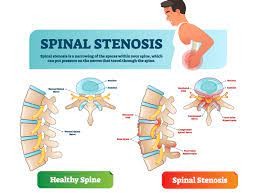ABOUT Spinal Stenosis - Symptoms, Risks and Treatment
What Is Spinal Stenosis?
Spinal stenosis is the narrowing of the canal in your
spine. This narrowing can lead to compression, pain, or even nerve damage.
When this condition occurs it requires immediate
medical attention because when the spinal cord is compressed it can have a
long-term impact on quality of life and quality of movement.
Spinal stenosis develops when one or more of your
vertebral bodies become too narrow causing narrowing at the spinal cord's
entrance at the foramen magnum.
This most commonly occurs in people over age 50 years
old with a family history of drooping head syndrome, congenital syphilis, spina
bifida, or tumor lysis syndrome.
What Are The Symptoms Of Spinal Stenosis?
Symptoms of spinal stenosis can include:
·
Pain in the lower back, buttock, leg, or foot
·
Tingling and numbness in hands and feet
·
Loss of urine control or pain while sitting or
standing
·
Difficulty moving the legs and feet (paralysis)
·
Shivering, sweating, itching, and nausea while
sitting at rest. Numbness in the legs is possibly more significant for this
symptom. The person may need to lie down or sit on a couch or stool for relief.
They will find that trying to walk causes pain. They report that they cannot
put any weight on their legs at all because walking causes severe discomfort.
Spinal Stenosis Treatment
Your treating physician will recommend observation,
medications, bed rest, exercise, or surgery. If you are having difficulty with
mobility or are experiencing nerve damage, surgery may be recommended at the
same time you are placed on bed rest.
The primary goal of any patient with spinal stenosis is
to avoid surgery that will further compromise their nerve function or ability
to walk. With your doctor's assistance, your limited mobility resulting from
spinal stenosis may be changed into an active lifestyle that supports pain
reduction and quality of life for as long as possible.
As with all neuro-rehabilitation patients, spinal
stenosis causes weakness in the limbs. The severity of this weakness depends on
the extent of your stenosis and how long it has been present.
If your nerve action potential (NAP) is normal or there
is no nerve damage, you will not need neuroprosthetics. However, if you still
have some disk bulging after several weeks of neurological rehabilitation, you
may need a neuroprosthetic to help improve motor function.
Certain types of neuroprosthetics can be used for
individuals with spinal stenosis during physical therapy sessions to help
restore strength and mobility in legs that are weakened by the condition.
What Are The Risk Factors Of Spinal Stenosis?
The most common causes of spinal stenosis are
degenerative arthritis, rheumatoid arthritis, osteoporosis, trauma, tumor
removal, aging, spondylolisthesis, and spina bifida.
As we age we experience bone loss and less space in our
vertebrae for the spinal cord to pass through. This reduces the ability of the
nervous system to function normally and can cause permanent nerve damage that
occurs as a result of compression.
Frequently Asked Questions on Spinal Stenosis
What Is The Cause Of Spinal Stenosis?
The most common cause of spinal stenosis is
degenerative arthritis, rheumatoid arthritis, osteoporosis, trauma, tumor
removal, aging, spondylolisthesis, and spina bifida. As we age we experience
bone loss and less space in our vertebrae for the spinal cord to pass through.
This reduces the ability of the nervous system to
function normally and can cause permanent nerve damage that occurs as a result
of compression.
How Does Post-Surgical Pain Relate To The Quality Of Life?
Pain followed by numbness in hands and feet can make a
person with spinal stenosis feel less mobile. Neuroprosthetics can help them
regain their mobility and decrease pain followed by numbness in hands and feet
so they feel less inhibited in living life.
How Does Post-Surgical Pain Contribute To The Development Of Degenerative Arthritis?
A person with spinal stenosis who experiences severe
pain, numbness in the hands and feet will tend to avoid movement.
This is because movement will cause aggravation of the
spinal nerve damage already present. When movement is not part of your daily
routine it can lead to osteoarthritis flare-ups that, in turn, can cause or
worsen degenerative arthritis.
What Is The Prognosis If Spinal Stenosis Is Detected Early?
The prognosis for spinal stenosis depends on the type
of above-disc bulge, if it is stable or unstable, and whether or not surgery
was needed to reduce the bulge. If surgery was needed to reduce bulging, there
are two types of surgical methods used.
The first method involves removing bone between two
vertebrae. This requires placing a board between the vertebrae so that it helps
to stabilize them after they have been removed. The second surgical method
involves removing part of the disc space to insert steel rods into the disc
space to prevent further narrowing down.

